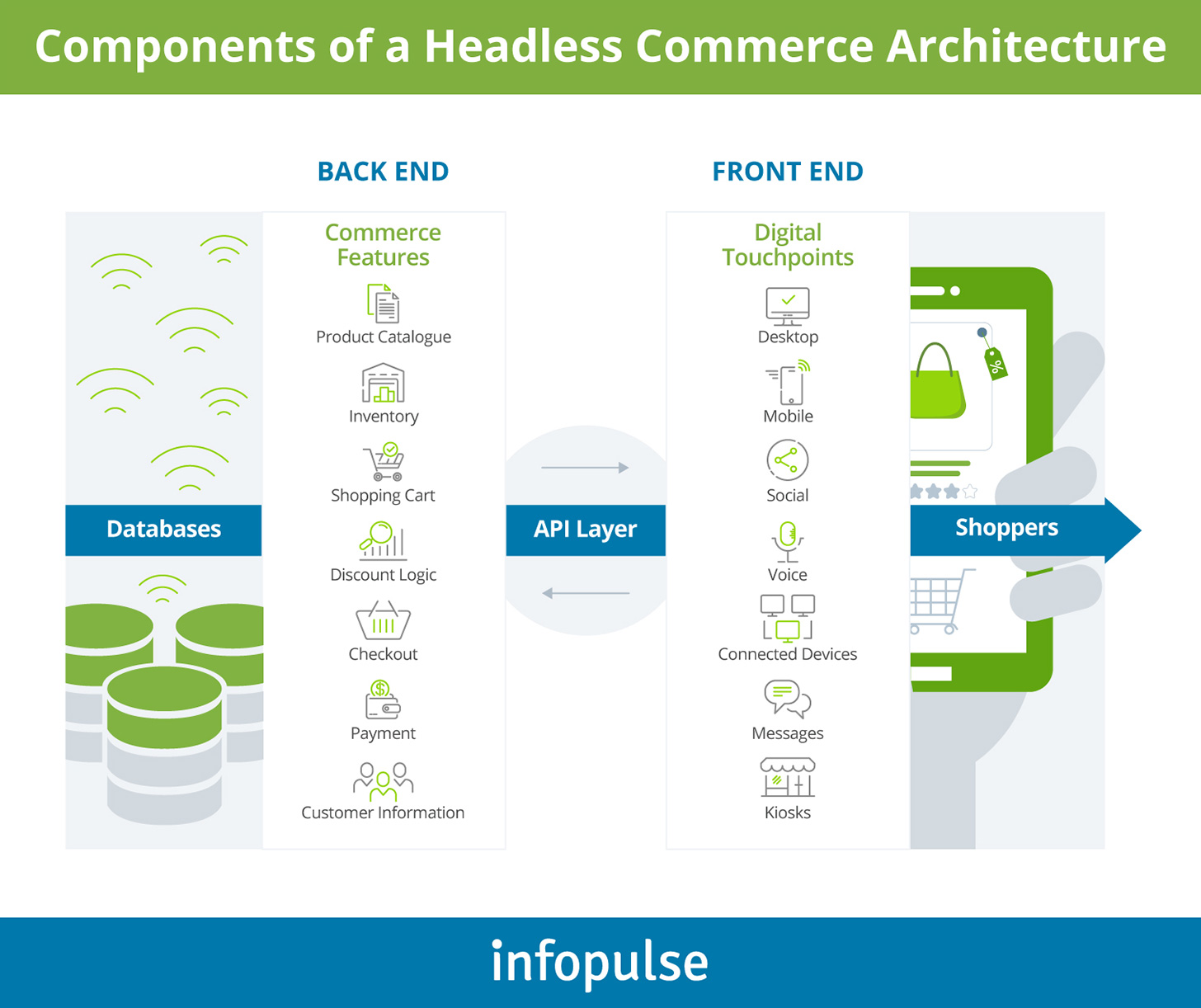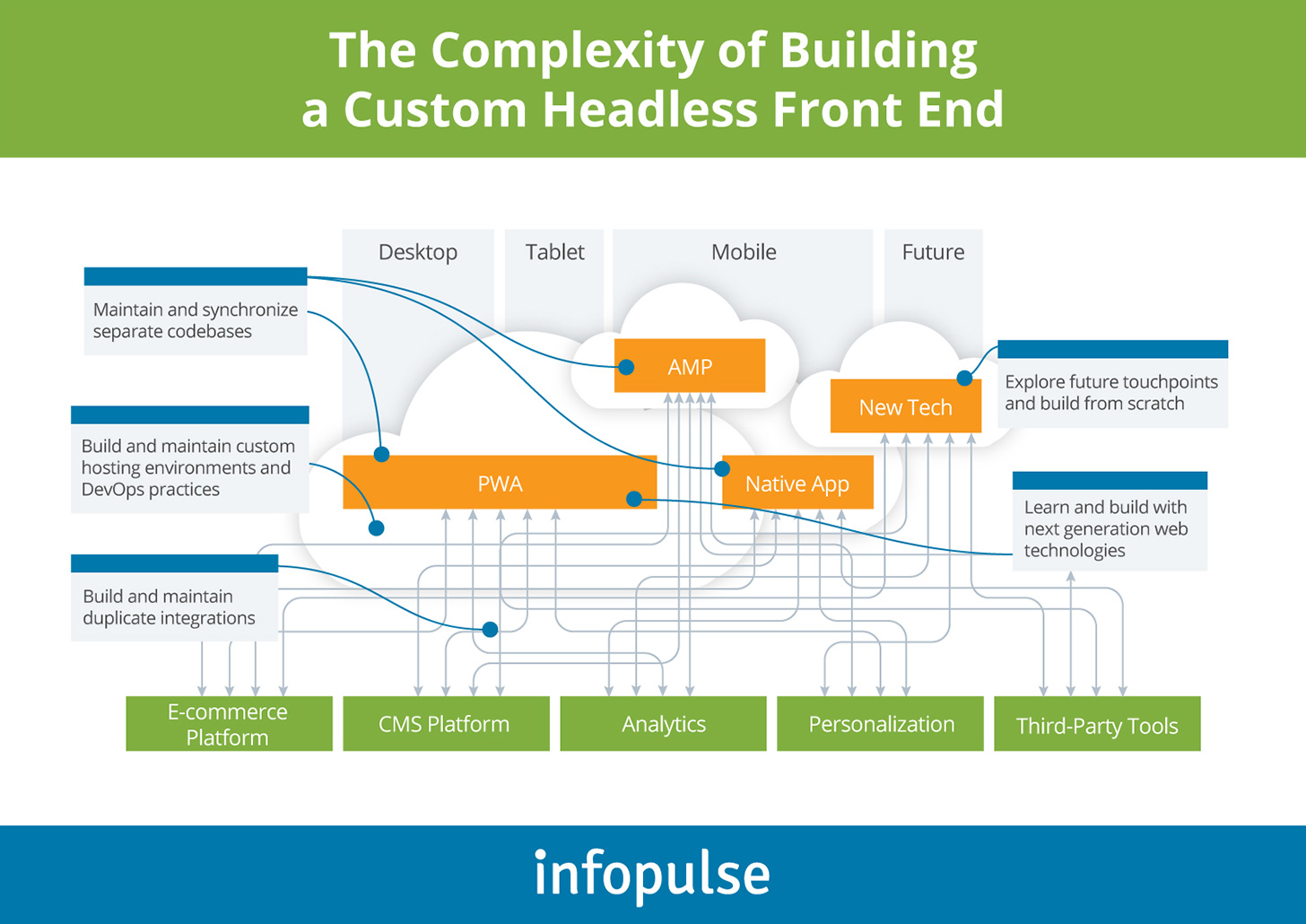How to Know Headless Commerce is for You: a Guide for Retailers
Headless commerce came to the fore as a springboard for CX innovation, enabling retailers to deliver engaging online shopping experiences rapidly and at scale. But what is a headless commerce solution and what are the tradeoffs for adoption? These are the questions we would like to help you answer.
What is Headless Commerce?
Headless commerce is a modular approach to architecting an e-commerce platform, where the back end (e.g., core commerce module) is separated from the front-end presentation layer customers interact with.
Based on the principles of microservices architecture, headless commerce enables retailers to combine best-in-class back-end hardware, systems, and technologies with innovative digital experience platforms (DXPs) or content management system (CMS) of their choice to deliver a top-notch omnichannel experience.

Headless commerce software comes in different configurations. Some vendors specialize in:
- Back-end solutions (e.g., BigCommerce Headless, Optimizely Commerce Cloud, Magento Commerce, CommerceTools).
- Others deliver headless CMS and digital experience platforms (e.g., Optimizely Content Cloud, Adobe Experience Manager, Contentful, etc.).
The underlying idea is that you can select any commerce core for your operations (or use a custom-built one). Then extend it with extra functionality via APIs. For example, integrate payment processing or inventory management software from another vendor. Finally, you can connect your back end with a customizable front end, scalable and adaptable to different channels your customers prefer.
Learn in detail about the difference between headless and traditional commerce in our article.
In this post, we will focus on how back-end headless commerce surpasses traditional commerce architecture and what makes the former a strong attractor for growing retailers.
Why Go for a Headless Commerce Solution
The e-commerce sector as a whole boomed in 2020 with a large proportion of sales projected to shift permanently from offline to online.
Between September 2019 and September 2020, the number of people who said they regularly or exclusively purchased everyday items online grew by 133%. Additionally, the volume of purchases among infrequent e-commerce users, those who made less than 25% of purchases online prior to the pandemic, increased by 343% in a year as well.
Furthermore, nearly every channel is now a customer shopping avenue — website, mobile app, social media, in-store self-service kiosks, and unattended retail solutions. Ensuring a consistent experience across all these touchpoints is a tough job for legacy monolith systems.
Headless commerce has increased the technical feasibility of delivering a convenient, on-brand experience across all retail channels. It also rapidly integrates new touchpoints to the distribution mix.
Headless Commerce Benefits
- Ability to use familiar tech stacks to develop new applications
- Rapid scalability to meet surged demand
- Full ownership over e-commerce platform architecture
- Minimization of vendor lock-in risks
- Agile incorporation of new channels and customer touchpoints
- Superior levels of an omnichannel experience
- Improved commerce platform maintainability
- Ability to adopt innovative technologies without expensive refactoring
- Improved customer acquisition and conversion rates
- Faster rate of experimentation and faster time-to-market for new products
Given that 56% of retailers expect the majority of their revenue to originate from digital channels in the next three years, it becomes even easier to understand the surged interest in headless commerce solutions.
Obstacles in Adopting Headless Architecture
Depending on your operations type and the start point of your headless transformation journey, you may be facing a different set of challenges.
Enterprise-sized companies often consider headless architecture as part of wider legacy software modernization projects. In such cases, the initial systems’ decoupling, upgrades to a microservices architecture to the cloud require targeted precision, expert execution, and significant budgets.
Replacing an on-premises installation with a cloud-based e-commerce platform also requires careful planning, both in regards to the overall infrastructure architecture and ongoing licensing and cloud computing costs.
Finally, comes the question of what technology should we use for the front end. You are not limited in technological options and can use any programming language or a combination of frameworks to deploy products across multiple channels. However, highly fragmented systems are more expensive and complex to maintain and secure.

Some headless commerce solutions come with a native or complementary CMS for easy integration. Other vendors have monoline offerings with only commerce features included. Respectively, you will need to decide if you:
- Plan to custom-code the presentation layer and all supporting functionality marketers can use to manage content, design website pages, or even new interactive website elements in the WYSIWYG environment.
- Want to invest in a supporting headless CMS or DXP solution for minimizing the other departments’ dependency on IT when it comes to content creation, management, and publishing.
Without the former, headless commerce may not be the most viable solution for mid-market retailers with limited IT resources and domain expertise. For larger enterprises, however, migration to headless commerce architecture assumes extra costs:
- Deploying and managing new infrastructure can lead to higher direct (licensing) and indirect costs (DevOps for maintaining microservices).
- Platform TCO can also increase based on the number of third-party tools integrated vs. obtained natively with the core commerce platform.
Ultimately, before taking the plunge, it is best to conduct an in-depth cost analysis of the migration costs versus benefits/savings generated. By taking a holistic look at your current portfolio and determining which sub-systems should be refactored, retired, or replaced with a better alternative, you should be able to work out which combination of headless solutions will offer the best cost-to-value ratio.
How to Shift to Headless Commerce: Step-By-Step
Headless empowers you to build any type of online shopping experience using the best-fitted tech stack for the purpose. The tradeoff, however, is that you end up with a more diverse portfolio of interconnected products, requiring orchestration, security, maintenance, and optimization individually and cumulatively.
The transition requires significant technical expertise with both the headless solution of your choice, as well as cloud infrastructure management in general. In addition, you should also have a clear roadmap for roll-out.
1. Start with an Infrastructure Assessment
Understanding the current state of your commerce capabilities (and technology shortcomings) is the first step towards modeling the optimal reference architecture for your headless e-commerce setup.
From a business perspective, ask yourself:
- Do you cover all retail channels you would like?
- Are there any weak areas due for improvement (based on teams’ feedback?
- Do you meet all customers’ requirements at every stage of their journey?
For example, Mazda US used to have a simple brochure-style website. However, the team recognized that most auto-shoppers began their research journey online, rather than with a dealership. Thus, the team decided to redesign their website using the Optimizely Cloud Commerce solution, paired with a headless Content Cloud module. The new mobile-friendly website featured interactive tools for researching car models and comparing car configurations. In two months post-launch, the website welcomed five million visitors and engagement levels increased by 200%.
From a technical perspective, consider the following:
- How fast can you launch new digital services?
- Do you need to redeploy the entire application after small changes?
- Do your platform components scale well individually?
- Can you easily refactor parts of your apps or front end?
Headless architecture reduces dependencies between individual apps. This, in turn, allows you to add extra functionality without meddling with core back-end systems. However, breaking down monolith systems into decoupled microservices is a complex technical process. Assess the gains and feasibility before committing to specific use cases.
The end result of this stage should be a clear list of objectives you plan to pursue, placed on an execution roadmap.
2. Choose a Suitable Headless Commerce Platform
Headless commerce is a cost-effective alternative to developing a custom e-commerce platform from scratch. Instead, you can license a suitable offering from a vendor, who would be responsible for ensuring compliance with industry regulations, back-end security, occasionally — hosting and payment processing.
There are several factors to consider when choosing a headless commerce platform:
- Pre-existing technical constraints (e.g., due to required compatibility with a legacy platform).
- Whether you have the capacity to do a greenfield deployment or will have to settle for a brownfield approach for now.
- Key project objectives and technical capabilities you would like to obtain post-migration.
As mentioned earlier, proprietary headless commerce solutions include both back-end solutions and front-end modules. Some vendors (e.g., Optimizely, SAP, Salesforce) offer both, meaning you can expect better synergy and faster project completion.
On the other hand, prioritizing a standalone back-end commerce solution (e.g., BigCommerce or Magento Commerce) leaves you with a wider range of integration opportunities and minimizes vendor lock-in risks.
3. Migrate and Support
Use the selected partner reference headless architecture as a baseline blueprint for customization. Based on the infrastructure assessment data, determine which modules should be turned into microservices and how they will communicate with the rest of the system. By carefully mapping your technology, you can understand how the new e-commerce platform will fit in with the rest of the architecture.
Next, create a separate document for your API strategy and spell out:
- Backward compatibility requirements
- Discoverability standards
- Orchestration and choreography
Separately, prepare a data migration plan. Specify the designated storage type for different types of assets and apps — on-premises, cloud, or hybrid. If migrating to the cloud, ensure that you have enough instances reserved for your databases.
Finally, mark the roll-out data and set forth new plans for supporting your platform and further orchestrating its performance.
To Conclude
Headless commerce solutions have an undeniably strong value proposition for the current fast-moving retail landscape. While the migration itself is an understandably complex undertaking, focus on the end results — access to more cost-effective business apps, innovative web development technologies such as progressive web app (PWA) and front-end frameworks, improved commerce analytics, and other revenue-driving platform extensions you would be able to leverage in your operations.
Considering headless? Contact Infopulse retail tech division to learn more about different target architectures, platforms, and roll-out scenarios for your business.


![CX with Virtual Assistants in Telecom [thumbnail]](/uploads/media/280x222-how-to-improve-cx-in-telecom-with-virtual-assistants.webp)
![How to Build Enterprise Software Systems [thumbnail]](/uploads/media/thumbnail-280x222-how-to-build-enterprise-software-systems.webp)
![Super Apps Review [thumbnail]](/uploads/media/thumbnail-280x222-introducing-Super-App-a-Better-Approach-to-All-in-One-Experience.webp)
![IoT Energy Management Solutions [thumbnail]](/uploads/media/thumbnail-280x222-iot-energy-management-benefits-use-сases-and-сhallenges.webp)

![5G Network Holes [Thumbnail]](/uploads/media/280x222-how-to-detect-and-predict-5g-network-coverage-holes.webp)
![How to Reduce Churn in Telecom [thumbnail]](/uploads/media/thumbnail-280x222-how-to-reduce-churn-in-telecom-6-practical-strategies-for-telco-managers.webp)
![White-label Mobile Banking App [Thumbnail]](/uploads/media/thumbnail-280x222-white-label-mobile-banking-application.webp)
![Money20/20 Key Points [thumbnail]](/uploads/media/thumbnail-280x222-humanizing-the-fintech-industry-money-20-20-takeaways.webp)
![Deepfake Detection [Thumbnail]](/uploads/media/thumbnail-280x222-what-is-deepfake-detection-in-banking-and-its-role-in-anti-money-laundering.webp)